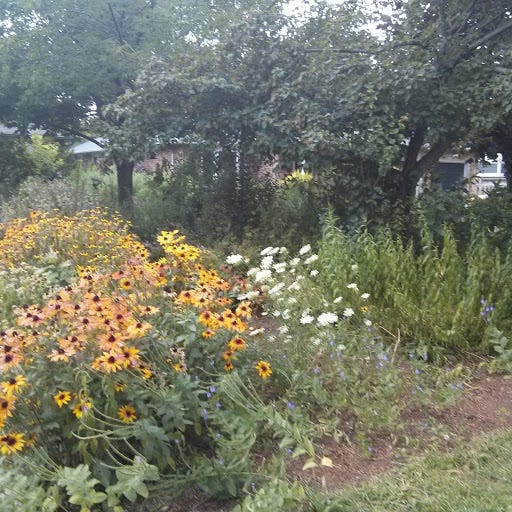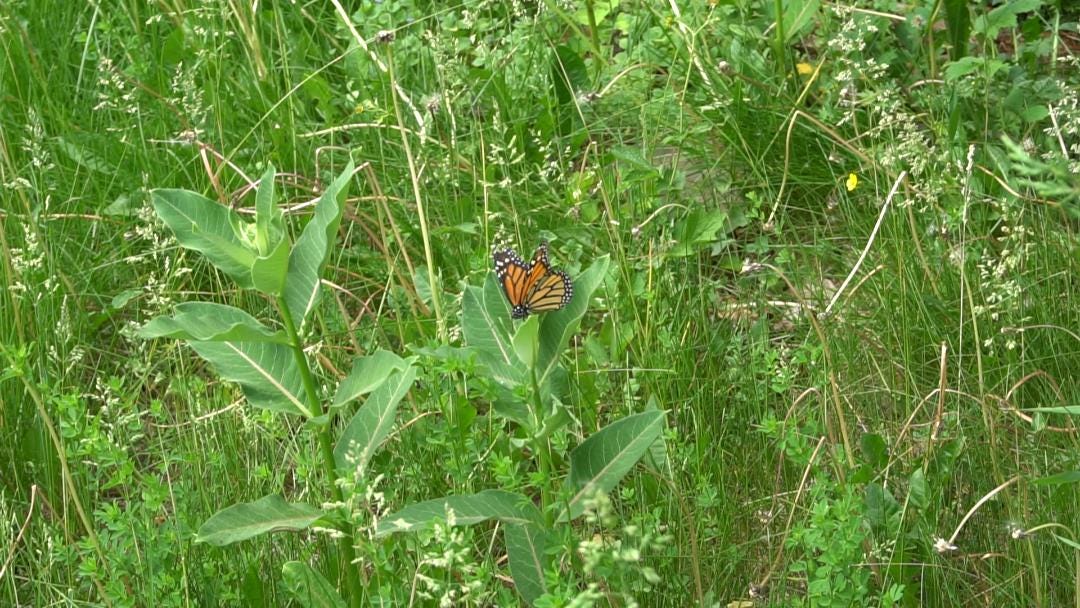Call for municipalities to turf grass for naturalized gardens teaming with life
“In the midst of an ecological crisis, it’s time to re-think our relationship with nature and value the regeneration of biodiversity over the aesthetic of domination,” Karen Barnes.
Paul Raun’s naturalized front yard in 2019. Credit: Doreen Nicoll
The Canadian Society of Landscape Architects (CSLA), the Canadian Wildlife Federation (CWF), the David Suzuki Foundation (DSF), the Ecological Design Lab located at Toronto Metropolitan University, and renowned author and environmental advocate Lorraine Johnson have joined forces to support the reforming of municipal bylaws to ensure these policies better support the development of habitat gardens.
Read their open letter to Canadian municipalities here.
Habitat gardens, also known as pollinator gardens, native plant gardens or naturalized landscapes, are spaces where traditional turfgrass lawns have been transformed into vibrant, thriving ecosystems.
These carefully cultivated gardens have plants that attract and support a diverse range of wildlife, including birds, bees, butterflies, and other beneficial organisms.
These gardens enrich communities by improving the quality of life and contributing to ecological stewardship.
While Johnson and the organizations acknowledge and celebrate the efforts municipalities have made, they are also encouraging essential bylaw reform along with enforcement policies and procedures to further enhance the work of folks and community groups.
"The last thing we need, at a time when climate change and biodiversity loss are making naturalization even more important than ever, is to have bylaw officers, who aren't experts in naturalization, handing out violation notices for naturalized yards that neighbours complain about just because they might look "messy" if judged by conventional garden aesthetics,” Johnson told Small Change via email.
“Naturalized yards often look different from the traditional gardens we might be familiar with, and naturalized yards definitely look different from lawns. Let's celebrate that fact, not punish people who are embracing a different "look" for a different goal like ecological health," Johnson added.
Let’s look at Burlington, ON to understand how municipal bylaws have simultaneously progressed and regressed.
In 2003, I took up my entire front lawn and created a meadow garden with mostly native plants interspersed with a few edibles like kale, squash, tomatoes and herbs like dill, basil and varieties of thyme.
Naturalized garden featuring common milkweed plants on the left. Credit: Doreen Nicoll
In 2018, I came home to find a notice on my door stating I was in contravention of By-law #12-2011 Part 3 3.1(b) which enforces, “Every owner of property shall ensure that grass and ground cover is trimmed or cut to a height of 20 centimeters (8inches) or less and shall ensure weeds are removed or destroyed between May 1 and October 15 each calendar year.”
I was given seven days to remove all of the common milkweed from my garden. If I refused, city workers would come and cut down the offending plants and bill me for the work.
Here’s the issue, milkweed was delisted from the provincial list of noxious weeds in 2014 and for several years the City of Burlington had been giving out milkweed seeds and plants for folks to put in their gardens to help revive the monarch population. In fact, the city was letting milkweed flourish on some of its own properties.
An article I published in rabble.ca about the absurdity of the situation brought an overwhelming response from folks right across Canada and the night before my garden was to be mowed down the bylaw was changed and my milkweed saved.
However, the 20 centimeters (8 inches) height restriction remained in place even though most plants – not just native plants – generally grow at least that tall if not taller.
The following year, a garden in south Burlington and another in the north were set to be mowed down if the owners did not remove the tall “weeds” from their native gardens. The problem, once again, was that there were no weeds in either garden.
In the case of Paul Raun’s south Burlington garden, he had spent hours and hundreds of dollars researching and sourcing native species, including trees, to fill his garden.
Raun established 23 varieties of wildflowers, 12 shrubs and vines, three wild grasses, a sycamore and a redbud tree all purchased from nurseries specializing in indigenous species.
Raun even stayed home from work for two days fearful his garden would be cut down by city workers. When bylaw did speak with Raun, they found no weeds or noxious plants. The offending vine and cypress trees identified by the bylaw officer belonged to neighbours on either side of Raun.
Despite the offending vine being a dog strangling vine — a restricted species under the Ontario Invasive Species Act — and the cypress trees being planted on the property line, no action was taken against the offending neighbours because no one had filed a complaint with bylaw about those front gardens.
Karen Barnes’ garden in north Burlington did not fair as well. City workers mowed every plant to a height of 2.5 centimeters (1 inch) —including milkweed. City workers decimated Barnes’ garden days before the official deadline issued by the city and while she was literally getting an injunction to stop the destruction of her garden. Read more here.
As recently as the summer of 2023 that same garden was once again mowed down by city workers because it was “messy” and the native plants were deemed “not purposely placed.”
North Burlington pollinator garden before the city cut it down in 2019. Credit: Doreen Nicoll
Barnes hired lawyer David Donnelly and is fighting Burlington’s lot maintenance by-law based on the fact that landscape design is an art form and artistic expression that is protected under the Canadian Charter of Rights and Freedoms.
“In the midst of an ecological crisis, it’s time to re-think our relationship with nature and value the regeneration of biodiversity over the aesthetic of domination,” Barnes told Small Change via email.
When Burlington updated its lot maintenance by-law in 2022 it specifically targeted Barnes’ garden including a caveat that plants must also be purposely placed which is counter intuitive for self-seeding plants like dill, black-eyed Susan and bee balm.
The current by-law also prohibits bee homes as well as enforcing mandatory raking of fall leaves where butterfly larvae overwinter; toads, shrews and salamanders hide and hunt; and beneficial microbes and worms thrive.
Enforcing the raking of leaves means either bagging the leaves in paper bags that are then pick up by truck or else the leaves are vacuumed up and deposited into a dump truck. Both methods are unnecessary and contribute to global warming.
Instead, let fallen leaves provide shelter for overwintering insects and small animals and then break down into natural mulch and fertilizer.
The most recent version of the bylaw includes a flat $100,000 fine for non-compliance. Additionally, Barnes was threatened with a $10,000 per day fine until she conforms with the bylaw. The city also made the unusual, and arguably unethical, choice to inform Barnes’ mortgage company of the possible fines which, to date, have not been issued.
"This isn't just happening in Burlington; it's happening in municipalities across the country. Vague and arbitrary property standards bylaws place a huge barrier in the way of positive environmental action. We need to weed out these bad bylaws and replace them with clear regulations in support of healthy yards and gardens," said Johnson.
That’s why this coalition of experts is calling on Canadian municipalities to ensure that reformed municipal bylaws support biodiversity and ecological health. They also want bylaw enforcement officers trained on native and prohibited plants as well as the legal rights of gardeners to express their environmental ethics.
“Amid a biodiversity crisis with an alarming decline of pollinators, municipalities should be making it easier, not harder for residents to foster gardens where native plants thrive,” stated Johnston.
The experts also believe municipalities should be leading by example and committed to community outreach and education to shift public perceptions while fostering understanding of sustainable practices.
Guelph pollinator garden and information signage in a municipal park. Credit: Doreen Nicoll
These measures would hopefully encourage a re-thinking of garden aesthetics where thriving ecosystems that support biodiversity and climate change resiliency — including aiding with storm water management during increasingly torrential rainfalls — replace over manicured turfgrass monoculture lawns.
The coalition is offering support for municipalities, organizations and individuals in their efforts to implement habitat gardens. Their combined collective expertise in environmental advocacy, ecological research, education and design, uniquely position them to support bylaw reform, bylaw officer training, the development of enforcement policies and procedures as well as the creation and delivery of public education and engagement programs.
Individuals can encourage their local government to update bylaws for diversity by signing the coalition’s petition here.
BENEFITS OF HABITAT GARDENS (provided by the coalition)
1. Increase Biodiversity: Habitat gardens support a variety of pollinators, birds, and other wildlife, and increase biological diversity.
2. Improve Air and Water Quality: Habitat gardens play a critical role in filtering pollutants from the air and water.
3. Reduce Erosion and Improve Soil Quality: Native meadow and prairie plants have deep root systems that enhance soil structure, increase water infiltration, and reduce runoff, preventing soil erosion and water pollution.
4. Enhance Urban Resilience: Habitat gardens provide natural cooling for cities, thereby reducing the unhealthy urban heat island effect.
5. Manage Stormwater: Habitat gardens can reduce local flooding by storing and slowing down stormwater, reducing the burden on stormwater infrastructure during extreme events.
6. Reduce Water Use: Native plants matched to landscape conditions are resilient and often require less irrigation during times of drought.
7. Sequester Carbon: By increasing plant biomass (both above and below the ground), habitat gardens store more carbon and contribute to climate change mitigation, through a process called carbon sequestration.
8. Enhance Health and Well-being: Habitat gardens connect us with nature, offering benefits that reduce stress and increase mental health and well-being, improving the quality of life.
9. Reduce maintenance costs: By reducing the need for extensive lawn care, such as reduced mowing, watering, chemical treatments, and yard waste collection, habitat gardens can offer cost savings for property owners, especially municipalities tasked with maintaining large areas of public land.
FEATURES OF BIODIVERSITY-SUPPORTING BYLAWS:
• List prohibited plants rather than using vague and subjective terms such as “weeds.”
• Engage with Indigenous communities and Rights holders to develop the list of prohibited plants.
• Specify that height restrictions apply to mowed lawns (turfgrass), not nonturfgrass plants that do not obstruct sightlines.
• Focus on health and safety rather than aesthetics, and avoid the use of subjective, aesthetically-based terms such as “excessive growth” and “tidy.”
• Offer clear support for the protection of habitat elements including fallen leaves and logs, and old plant stalks.
Helpful resources for municipalities and advocacy groups are available for download under Bylaws for Biodiversity, including a research report on municipal codes and a Toolkit for Local Governments developed by the Ecological Design Lab at the Toronto Metropolitan University.
Progressive City of Guelph teams up homeowners with folks from University of Guelph to create edible front gardens. Credit: University of Guelph
Thanks to everyone who read today’s article. With your continued support, a little Nicoll can make a lot of change.








This can’t be said often enough! I notice that along the lakeshore where the banks are eroding the city has naturalized to help hold the soil. Someone has realized the value of indigenous plants!
Fabulous article. Profound thanks for getting this critical information out.